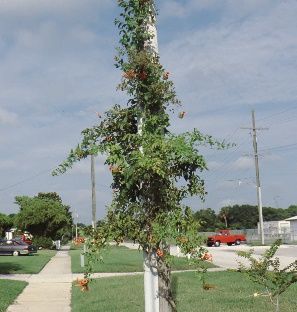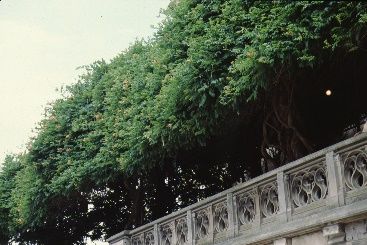Introduction
Trumpet vine climbs to 30 feet or more when given support. The brilliant orange flowers are borne in summer and are often visited by hummingbirds. They will hang down from an arbor or trellis making a wonder "wall" or "ceiling" in a garden. Rapid growth makes training easy, but regular pinching and pruning is required to establish this vine on a structure. The invasive nature of the plant makes it hard to get rid of once it is established in the yard. Ants often live on trumpet vine and are sometimes found objectionable by gardeners. The thick, woody stem can grow between wooden house siding and destroy it. It is best suited for planting at the base of an arbor or trellis. It can also be used in a container where it will cascade over the side.

Credit: Edward F. Gilman, UF/IFAS

Credit: Edward F. Gilman, UF/IFAS

Credit: Edward F. Gilman, UF/IFAS
General Information
Scientific name: Campsis radicans
Pronunciation: KAMP-sis RAD-ick-anz
Common name(s): trumpet creeper, trumpet vine
Family: Bignoniaceae
Plant type: vine
USDA hardiness zones: 4B through 10A (Figure 4)
Planting month for zone 7: year round
Planting month for zone 8: year round
Planting month for zone 9: year round
Planting month for zone 10 and 11: year round
Origin: native to Florida
Invasive potential: native plant that often reproduces into nearby landscapes
Uses: hanging basket; attracts hummingbirds
Availability: somewhat available, may have to go out of the region to find the plant

Credit: undefined
Description
Height: depends upon supporting structure
Spread: depends upon supporting structure
Plant habit: spreading
Plant density: moderate
Growth rate: fast
Texture: medium
Foliage
Leaf arrangement: opposite/subopposite
Leaf type: odd-pinnately compound
Leaf margin: dentate
Leaf shape: ovate
Leaf venation: pinnate
Leaf type and persistence: deciduous
Leaf blade length: 2 to 4 inches
Leaf color: green
Fall color: orange
Fall characteristic: not showy
Flower
Flower color: yellow
Flower characteristic: summer flowering
Fruit
Fruit shape: pod or pod-like
Fruit length: 3 to 6 inches
Fruit cover: dry or hard
Fruit color: brown
Fruit characteristic: persists on the plant
Trunk and Branches
Trunk/bark/branches: typically multi-trunked or clumping stems
Current year stem/twig color: brown
Current year stem/twig thickness: medium
Culture
Light requirement: plant grows in part shade/part sun
Soil tolerances: occasionally wet; slightly alkaline; clay; sand; acidic; loam
Drought tolerance: high
Soil salt tolerances: poor
Plant spacing: 36 to 60 inches
Other
Roots: not applicable
Winter interest: no special winter interest
Outstanding plant: not particularly outstanding
Pest resistance: no serious pests are normally seen on the plant
Use and Management
Like many vines, trumpet vine flowers best in a full sun location. It grows but flowers poorly in a shaded location. It will do fine in any soil except those kept continually wet and flooded.
There are several cultivars: 'Atropurpurea' - large, dark red flowers; 'Speciosa' - bushy growth habit; 'Flava' - yellow flowers; 'Praecox' - blooms earlier.
Planthoppers may occasionally feed on trumpet vine. The insects generally cause no serious damage, so controls are not needed.
Pests and Diseases
Leaf spot caused by various fungi may be seen but are not serious.
Powdery mildew causes a white powdery growth on the leaves.